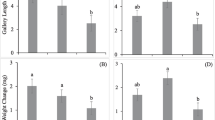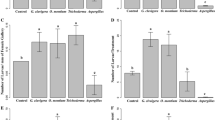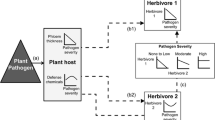Abstract
Mountain pine beetle (MPB) has recently expanded its host range to the novel jack pine forests in Alberta. Invasion success of MPB may depend on the outcome of interactions between its symbiotic fungus Grosmannia clavigera and Ophiostoma ips, a fungal associate of a potential competitor Ips pini. However, how the quality of jack pine phloem could influence interactions between the fungi is unknown. We investigated whether introduced concentrations of host nitrogen and monoterpenes affect the growth of and interaction between the fungi. Nitrogen concentrations did not affect the growth rate of either fungus. In the absence of monoterpenes, the presence of O. ips promoted G. clavigera growth. Monoterpenes either promoted or inhibited the growth of both fungi, and altered the outcome of species interactions from facilitation to no-effect. Overall, these results suggest that jack pine phloem quality and the presence of a niche-sharing fungus could influence MPB development.



Similar content being viewed by others
References
Ingham RE, Trofymow JA, Ingham ER, Coleman DC (1985) Interactions of bacteria, fungi, and their nematode grazers: effects on nutrient cycling and plant growth. Ecol Monogr 55:119–140. https://doi.org/10.2307/1942528
Read DJ, Perez-Moreno J (2003) Mycorrhizas and nutrient cycling in ecosystems–a journey towards relevance? New Phytol 157:475–492. https://doi.org/10.1046/j.1469-8137.2003.00704.x
van der Heijden MGA, Klironomos JN, Ursic M, Moutoglis P, Streitwolf-Engel R, Boller T et al (1998) Mycorrhizal fungal diversity determines plant biodiversity, ecosystem variability and productivity. Nature 396:69–72. https://doi.org/10.1038/23932
Rayner ADM, Boddy L (1988) Fungal decomposition of wood: its biology and ecology. Wiley, Sussex
Boddy L (2000) Interspecific combative interactions between wood-decaying Basidiomycetes. FEMS Microbiol Ecol 31:185–194. https://doi.org/10.1111/j.1574-6941.2000.tb00683.x
Carroll G, Wicklow D (1992) The fungal community: its organization and role in the ecosystem. Marcel Dekker, New York
Klepzig K, Flores-Otero J, Hofstetter RW, Ayres MP (2004) Effects of available water on growth and competition of southern pine beetle associated fungi. Mycol Res 108:183–188. https://doi.org/10.1017/s0953756203009055
Bleiker KP, Six DL (2009) Effects of water potential and solute on the growth and interactions of two fungal symbionts of the mountain pine beetle. Mycol Res 113:3–15. https://doi.org/10.1016/j.mycres.2008.06.004
Paine TD, Raffa KF, Harrington TC (1997) Interactions among scolytid bark beetles, their associated fungi, and live host conifers. Annu Rev Entomol 42:179–206. https://doi.org/10.1146/annurev.ento.42.1.179
Bleiker KP, Six DL (2007) Dietary benefits of fungal associates to an eruptive herbivore: potential implications of multiple associates on host population dynamics. Environ Entomol 36:1384–1396. https://doi.org/10.1093/ee/36.6.1384
Boone CK, Aukema BH, Bohlmann J, Carroll AL, Raffa KF (2011) Efficacy of tree defense physiology varies with bark beetle population density: a basis for positive feedback in eruptive species. Can J For Res 41:1174–1188. https://doi.org/10.1139/x11-041
Keeling CI, Bohlmann J (2006) Genes, enzymes and chemicals of terpenoid diversity in the constitutive and induced defence of conifers against insects and pathogens. New Phytol 170:657–675. https://doi.org/10.1111/j.1469-8137.2006.01716
Raffa KF, Aukema BH, Erbilgin N, Klepzig KD, Wallin KF (2005) Interactions among conifer terpenoids and bark beetles across multiple levels of scale: an attempt to understand links between population patterns and physiological processes. Recent Adv Phytochem 39:79–118
Raffa KF, Aukema BH, Bentz BJ, Carroll AL, Hicke JA, Turner MG, Romme WH (2008) Cross-scale drivers of natural disturbances prone to anthropogenic amplification: the dynamics of bark beetle eruptions. Bioscience 58:501–517. https://doi.org/10.1641/b580607
Adams A, Six D (2007) Temporal variation in mycophagy and prevalence of fungi associated with developmental stages of Dendroctonus ponderosae (Coleoptera: Curculionidae). Environ Entomol 36:64–72. https://doi.org/10.1093/ee/36.1.64
Ayres M, Wilkens R, Ruel J, Lombardero M, Vallery E (2000) Nitrogen budgets of phloem-feeding bark beetles with and without symbiotic fungi. Ecology 81:2198–2210. https://doi.org/10.1890/0012-9658(2000)081[2198:NBOPFB]2.0.CO;2
Cale JA, Muskens M, Najar A, Ishangulyyeva G, Hussain A, Kanekar SS, Klutsch JG, Taft S, Erbilgin N (2017) Rapid monoterpene induction promotes the susceptibility of a novel host pine to mountain pine beetle colonization but not to beetle-vectored fungi. Tree Physiol 37:1597–1610. https://doi.org/10.1093/treephys/tpx089
Raffa KF, Smalley EB (1995) Interaction of pre-attack and induced monoterpene concentrations in host conifer defense against bark beetle-fungal complexes. Oecologia 102:285–295. https://doi.org/10.1007/bf00329795
Klepzig KD, Six DL (2004) Bark beetle-fungal symbiosis: context dependency in complex associations. Symbiosis 37:189–205
Rudinsky JA (1962) Ecology of Scolytidae. Annu Rev Entomol 7:327–348. https://doi.org/10.1146/annurev.en.07.010162.001551
Raffa KF, Berryman AA (1983) The role of host plant resistance in the colonization behavior and ecology of bark beetles (Coleoptera: Scolytidae). Ecol Monogr 53:27–49. https://doi.org/10.2307/1942586
Whitney HS (1982) Relationships between bark beetles and symbiotic organisms. In: Mitton JB, Sturgeon KB (eds) Bark beetles in North America. University of Texas, Austin, pp 183–211
Six DL, Wingfield MJ (2011) The role of phytopathogenicity in bark beetle–fungus symbioses: a challenge to the classic paradigm. Annu Rev Entomol 56:255–272. https://doi.org/10.1146/annurev-ento-120709-144839
DiGuistini S, Ralph SG, Lim YW, Holt R, Jones S, Bohlmann J, Breuil C (2007) Generation and annotation of lodgepole pine and oleoresin-induced expressed sequences from the blue-stain fungus Ophiostoma clavigerum, a mountain pine beetle-associated pathogen. FEMS Microbiol Lett 267:151–158. https://doi.org/10.1111/j.1574-6968.2006.00565.x
Dl S, Klepzig KD (2004) Dendroctonus bark beetles as model systems for studies on symbiosis. Symbiosis 37:207–232
Bentz BJ, Six DL (2006) Ergosterol content of fungi associated with Dendroctonus ponderosae and Dendroctonus rufipennis (Coleoptera: Curculionidae, Scolytinae). Ann Entomol Soc Am 99:189–194. https://doi.org/10.1603/0013-8746(2006)099[0189:ECOFAW]2.0.CO;2
Clayton RB (1964) The utilization of sterols by insects. J Lipid Res 15:3–19
Norris DM, Baker JM, Chu HM (1969) Symbiotic interrelationships between microbes and ambrosia beetles III. Ergosterol as the source of sterol to the insect. Ann Entomol Soc Am 62:413–414. https://doi.org/10.1093/aesa/62.2.413
Therrien J, Mason CJ, Cale JA, Adams A, Aukema BH, Currie CC, Raffa KF, Erbilgin N (2015) Bacteria influence mountain pine beetle brood development through interactions with symbiotic and antagonistic fungi: implications for climate-driven host range expansion. Oecologia 179:467–485. https://doi.org/10.1007/s00442-015-3356-9
Goodsman DW, Erbilgin N, Lieffers VJ (2012) The impact of phloem nutrients on overwintering mountain pine beetles and their fungal symbionts. Environ Entomol 41:478–486. https://doi.org/10.1603/en11205
Ishangulyyeva G, Najar A, Curtis JM, Erbilgin N (2016) Fatty acid composition of novel host jack pine do not prevent host acceptance and colonization by the invasive mountain pine beetle and its symbiotic fungus. PLoS One 11:e0162046. https://doi.org/10.1371/journal.pone.0162046
Myrholm CL, Langor DW (2015) Assessment of the impact of symbiont Ophiostomatales (fungi) on mountain pine beetle (Coleoptera: Curculionidae) performance on a jack pine (Pinaceae) diet using a novel in vitro rearing method. Can Entomol 148:68–82. https://doi.org/10.4039/tce.2015.28
Six DL, Paine TD (1998) Effects of mycangial fungi and host tree species on progeny survival and emergence of Dendroctonus ponderosae (Coleoptera: Scolytidae). Environ Entomol 27:1393–1401. https://doi.org/10.1093/ee/27.6.1393
Bentz BJ, Régnière J, Fettig C, Hansen E, Hayes J, Hicke J et al (2010) Climate change and bark beetles of the western United States and Canada: direct and indirect effects. Bioscience 60:602–613. https://doi.org/10.1525/bio.2010.60.8.6
Safranyik L, Carroll AL, Régnière J, Langor DW, Riel WG, Shore TL et al (2010) Potential for range expansion of mountain pine beetle into the boreal forest of North America. Can Entomol 142:415–442. https://doi.org/10.4039/n08-cpa01
Cullingham CI, Cooke JEK, Dang S, Davis CS, Cooke BJ, Coltman DW (2011) Mountain pine beetle host-range expansion threatens the boreal forest. Mol Ecol 20:2157–2171. https://doi.org/10.1111/j.1365-294x.2011.05086.x
Erbilgin N, Ma C, Whitehouse C, Shan B, Najar A, Evenden M (2014) Chemical similarity between historical and novel host plants promotes range and host expansion of the mountain pine beetle in a naïve host ecosystem. New Phytol 201:940–950. https://doi.org/10.1111/nph.12573
Lusebrink I, Erbilgin N, Evenden M (2013) The lodgepole × jack pine hybrid zone in Alberta, Canada: a stepping stone for the mountain pine beetle on its journey east across the boreal forest? J Chem Ecol 39:1209–1220. https://doi.org/10.1007/s10886-013-0334-8
Erbilgin N (2019) Phytochemicals as mediators for host range expansion of a native invasive forest insect herbivore. New Phytol 221:1268–1278. https://doi.org/10.1111/nph.15467
Lee S, Kim JJ, Breuil C (2005) Leptographium longiclavatum sp. nov., a new species associated with the mountain pine beetle, Dendroctonus ponderosae. Mycol Res 109:1162–1170. https://doi.org/10.1017/s0953756205003588
Lee S, Kim JJ, Breuil C (2006) Diversity of fungi associated with the mountain pine beetle, Dendroctonus ponderosae and infested lodgepole pines in British Columbia. Fungal Divers 22:91–105
Roe AD, James PMA, Rice AV, Cooke JEK, Sperling FAH (2011) Spatial community structure of mountain pine beetle fungal symbionts across a latitudinal gradient. Microb Ecol 62:347–360. https://doi.org/10.1007/s00248-011-9841-8
Six DL (2003) A comparison of mycangial and phoretic fungi of individual mountain pine beetles. Can J For Res 33:1331–1334. https://doi.org/10.1139/x03-047
Whitney HS, Farris SH (1970) Maxillary mycangium in the mountain pine beetle. Science 167:54–55. https://doi.org/10.1126/science.167.3914.54
Erbilgin N, Nordheim EV, Aukema BH, Raffa KF (2002) Population dynamics of Ips pini and Ips grandicollis in red pine plantations in Wisconsin: within- and between-year associations with predators, competitors, and habitat quality. Environ Entomol 31:1043–1051. https://doi.org/10.1603/0046-225x-31.6.1043
Erbilgin N, Raffa KF (2002) Association of declining red pine stands with reduced populations of bark beetle predators, seasonal increases in root colonizing insects, and incidence of root pathogens. Forest Ecol Manag 164:221–236. https://doi.org/10.1016/s0378-1127(01)00596-5
Kegley S, Livingston R, Gibson K (1997) Pine engraver, Ips pini (Say), in the western United States. USDA Forest Service, Forest Insect and Disease Leaflet 122, pp 5.
Kopper BJ, Klepzig KD, Raffa KF (2004) Components of antagonism and mutualism in Ips pini–fungal interactions: relationship to a life history of colonizing highly stressed and dead trees. Environ Entomol 33:28–34. https://doi.org/10.1603/0046-225x-33.1.28
Kopper BJ, Illman BL, Kersten PJ, Klepzig KD, Raffa KD (2005) Effects of diterpene acids on components of a conifer bark beetle–fungal interaction: tolerance by Ips pini and sensitivity by its associate Ophiostoma ips. Environ Entomol 34:486–493. https://doi.org/10.1603/0046-225x-34.2.486
Schenk JA, Benjamin DM (1969) Notes on the biology of Ips pini in Central Wisconsin jack pine forests. Ann Entomol Soc Am 62:480–485. https://doi.org/10.1093/aesa/62.3.480
Colgan LJ, Erbilgin N (2010) The ecological interaction of the mountain pine beetle and jack pine budworm in the boreal forest. Forest Chron 86:766–774. https://doi.org/10.5558/tfc86766-6
Schenk JAL, Benjamin DM (1969) Notes on the biology of Ips pini in Central Wisconsin jack pine forests, Pinus banksiana. Ann Entomol Soc Am 62:480–485
Klepzig KD, Raffa KF, Smalley EB (1991) Association of insect-fungal complexes with red pine decline in Wisconsin. For Sci 37:1119–1139
Rankin LJ, Borden JH (1991) Competitive interactions between the mountain pine beetle and the pine engraver in lodgepole pine. Can J For Res 21:1029–1036. https://doi.org/10.1139/x91-141
Furniss MM, Carolin VM (1977) Western forest insects. USDA for. Serv. Misc. Publ. No. 1339.Safranyik and Linton 1991
Safranyik L, Shore TL, Linton DA (1996) Ipsdienol and lanierone increases Ips pini Say (Coleoptera: Scolytidae) attacks and brood density in lodgepole pine infested by mountain pine beetle. Can Entomol 128:199–207. https://doi.org/10.4039/Ent128199-2
Esch ED, Spence JR, Langor DW (2016) Saproxylic beetle (Coleoptera) diversity in subalpine whitebark pine and lodgepole pine (Pinaceae) trees killed by mountain pine beetles (Coleoptera: Curculionidae). Can Entomol 148:556–568. https://doi.org/10.4039/tce.2016.3
Lusebrink I, Erbilgin N, Evenden ML (2016) The effect of water limitation on volatile emission, tree defense response, and brood success of Dendroctonus ponderosae in two pine hosts, lodgepole, and jack pine. Front Ecol Evol 4. https://doi.org/10.3389/fevo.2016.00002
Guevara-Razo S, Classens G, Hussain A, Erbilgin N (2019) Short and long-term storage of jack pine bolts in associated with higher concentrations of monoterpenes and nutrients. Can J For Res 49:305–308. https://doi.org/10.1139/cjfr-2018-0305
Hussain A, Classens G, Guevara-Rozo S, Erbilgin N (2019) Soil and phloem nutrients altered the host acceptance and reproduction of mountain pine beetle in its novel host. Environ Entomol 48:945–952. https://doi.org/10.1093/ee/nvz054
Hussain A, Classens G, Guevara-Roxo S, Cale JA, Rajabzadeh R, Peters BR, Erbilgin N (2020) Spatial variation in soil available water holding capacity alters carbon mobilization and allocation to chemical defenses along jack pine stems. Environ Exp Bot 171:103902. https://doi.org/10.1016/j.envexpbot.2019.103902
Erbilgin N, Cale JA, Lusebrink I, Najar A, Klutsch JG, Sherwood P, Bonello P, Evenden ML (2016) Water-deficit and fungal infection can differentially affect the production of different classes of defense compounds in two host pines of mountain pine beetle. Tree Physiol 37:338–350. https://doi.org/10.1093/treephys/tpw105
Klutsch JG, Erbilgin N (2018) Dwarf mistletoe infection in jack pine alters growth–defense relationships. Tree Physiol 38:1538–1547. https://doi.org/10.1093/treephys/tpy090
Klutsch JG, Najar A, Cale JA, Erbilgin N (2016) Direction of interaction between mountain pine beetle (Dendroctonus ponderosae) and resource-sharing wood-boring beetles depends on plant parasite infection. Oecologia 182:1–12. https://doi.org/10.1007/s00442-016-3559-8
Klutsch JG, Najar A, Sherwood P, Bonello P, Erbilgin N (2017) A native parasitic plant systemically induces resistance in jack pine to a fungal symbiont of invasive mountain pine beetle. J Chem Ecol 43:506–518. https://doi.org/10.1007/s10886-017-0845-9
Abramoff M, Magalgaes PJ, Ram SJ (2004) Image processing with ImageJ. Biophoton Int 11:36–42 K
R Core Team (2017) R: a language and environment for statistical computing. R Foundation for Statistical Computing, Vienna
Paine TD, Hanlon CC (1994) Influence of oleoresin constituents from Pinus ponderosa and Pinus jeffreyi on growth of mycangial fungi from Dendroctonus ponderosae and Dendroctonus jeffreyi. J Chem Ecol 20:2551–2563
Chiu CC, Keeling CI, Bohlmann J (2017) Toxicity of pine monoterpenes to mountain pine beetle. Sci Rep 7:8858. https://doi.org/10.1038/s41598-017-08983-y
Reid ML, Sekhon JK, LaFramboise LM (2017) Toxicity of monoterpene identity, diversity, and concentration to mountain pine beetles, Dendroctonus ponderosae: beetle traits matter more. J Chem Ecol 43:351–361. https://doi.org/10.1007/s10886-017-0824-1
Wang Y, Lim L, DiGuistini S, Robertson G, Bohlmann J, Breuil C (2012) A specialized ABC efflux transporter GcABC-G1 confers monoterpene resistance to Grosmannia clavigera, a bark beetle-associated fungal pathogen of pine trees. New Phytol 197:886–898. https://doi.org/10.1111/nph.12063
Wang Y, Lim L, Madilao L, Lah L, Bohlmann J, Breuil C (2014) Gene discovery for enzymes involved in limonene modification or utilization by the mountain pine beetle-associated pathogen Grosmannia clavigera. Appl Environ Microbiol 80:4566–4576. https://doi.org/10.1128/aem.00670-14
Mattson WJ (1980) Herbivory in relation to plant nitrogen content. Annu Rev Ecol Syst 11:119–161. https://doi.org/10.1146/annurev.es.11.110180.001003
Colgan LJ, Erbilgin N (2011) Tree-mediated interactions between the jack pine budworm and a mountain pine beetle fungal associate. Ecol Entomol 36:425–434. https://doi.org/10.1111/j.1365-2311.2011.01283.x
Adhikari B, Hamilton J, Zerillo M, Tisserat N, Lévesque C, Buell C (2013) Comparative genomics reveals insight into virulence strategies of plant pathogenic oomycetes. PLoS One 8:e75072. https://doi.org/10.1371/journal.pone.0075072
Jankowiak R, Bilański P (2013) Ophiostomatoid fungi associated with root-feeding bark beetles on Scots pine in Poland. For Pathol 43:422–428. https://doi.org/10.1111/efp.12049
Raffa KF, Mason CJ, Bonello P, Cook S, Erbilgin N, Keefover-Ring K et al (2017) Defence syndromes in lodgepole–whitebark pine ecosystems relate to degree of historical exposure to mountain pine beetles. Plant Cell Environ 40:1791–1806. https://doi.org/10.1111/pce.12985
Kim J-J, Kim SH, Lee S, Breuil C (2003) Distinguishing Ophiostoma ips and Ophiostoma montium, two bark beetle-associated sapstain fungi. FEMS Microbiol Let 222:187–192. https://doi.org/10.1016/S0378-1097(03)00304-5
Bleiker KP, Six DL (2009) Competition and coexistence in a multi-partner mutualism: interactions between two fungal symbionts of the mountain pine beetle in beetle-attacked trees. Microb Ecol 57:191–202. https://doi.org/10.1007/s00248-008-9395-6
Acknowledgments
We thank Tod Ramsfield at Northern Forestry Centre for providing the fungal culture and endless support. We would like to also thank Guncha Ishangulyyeva, Altaf Hussain, and everyone else in Erbilgin’s lab for providing laboratory and field assistance.
Funding
This work was supported by funding provided by Canada Foundation of Innovation and NSERC–Discovery Award to Nadir Erbilgin.
Author information
Authors and Affiliations
Corresponding author
Rights and permissions
About this article
Cite this article
Wang, F., Cale, J.A. & Erbilgin, N. Induced Defenses of a Novel Host Tree Affect the Growth and Interactions of Bark Beetle-Vectored Fungi. Microb Ecol 80, 181–190 (2020). https://doi.org/10.1007/s00248-020-01490-0
Received:
Accepted:
Published:
Issue Date:
DOI: https://doi.org/10.1007/s00248-020-01490-0




